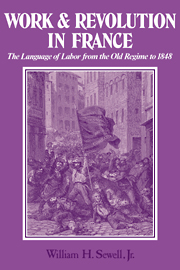Book contents
- Frontmatter
- Contents
- Preface
- 1 INTRODUCTION: SOCIAL HISTORY AND THE LANGUAGE OF LABOR
- 2 MECHANICAL ARTS AND THE CORPORATE IDIOM
- 3 JOURNEYMEN'S BROTHERHOODS
- 4 THE ABOLITION OF PRIVILEGE
- 5 FROM GENS DE MÉTIER TO SANS-CULOTTES
- 6 A REVOLUTION IN PROPERTY
- 7 INDUSTRIAL SOCIETY
- 8 WORKERS' CORPORATIONS
- 9 THE JULY REVOLUTION AND THE EMERGENCE OF CLASS CONSCIOUSNESS
- 10 THE PARADOXES OF LABOR
- 11 THE REVOLUTION OF 1848
- 12 CONCLUSION: THE DIALECTIC OF REVOLUTION
- Notes
- Bibliography
- Index
Preface
Published online by Cambridge University Press: 06 November 2009
- Frontmatter
- Contents
- Preface
- 1 INTRODUCTION: SOCIAL HISTORY AND THE LANGUAGE OF LABOR
- 2 MECHANICAL ARTS AND THE CORPORATE IDIOM
- 3 JOURNEYMEN'S BROTHERHOODS
- 4 THE ABOLITION OF PRIVILEGE
- 5 FROM GENS DE MÉTIER TO SANS-CULOTTES
- 6 A REVOLUTION IN PROPERTY
- 7 INDUSTRIAL SOCIETY
- 8 WORKERS' CORPORATIONS
- 9 THE JULY REVOLUTION AND THE EMERGENCE OF CLASS CONSCIOUSNESS
- 10 THE PARADOXES OF LABOR
- 11 THE REVOLUTION OF 1848
- 12 CONCLUSION: THE DIALECTIC OF REVOLUTION
- Notes
- Bibliography
- Index
Summary
I BEGAN THIS BOOK with the intention of writing a brief article on the ideology of French workers during the Revolution of 1848. The article was to explore an intriguing but little-noticed paradox: that the discourse of revolutionary workers in 1848 was laced with seemingly archaic terminology dating from the guild or corporate system of the old regime. By analyzing this use of corporate terminology, I meant to show that the new socialist vision the workers were developing in 1848 was founded on a very old sense of craft community. I quicklyfound that the subject was both richer and much more complex than I had imagined, and by the time I had finished a draft of my article it was more than twice as long as I had planned. More alarming yet, when I showed the draft to friends and colleagues, their opinion was unanimous: It had to be either cut and simplified or expanded into a book. I tried the first alternative, but after two months of work I foundthe essay longer and more complex than ever. Analyzing and explaining the workers' use of corporate language in 1848 seemed to lead me in all directions at once: to corporate institutions under the old regime, to the historical relationship between corporate and revolutionaryforms of language and organization, to the changing work process in artisan shops, to the means employed by workers in struggles with their employers, to changes in property relations, to the impact of the Revolutions of 1789 and 1830, and so on.
- Type
- Chapter
- Information
- Work and Revolution in FranceThe Language of Labor from the Old Regime to 1848, pp. ix - xPublisher: Cambridge University PressPrint publication year: 1980

